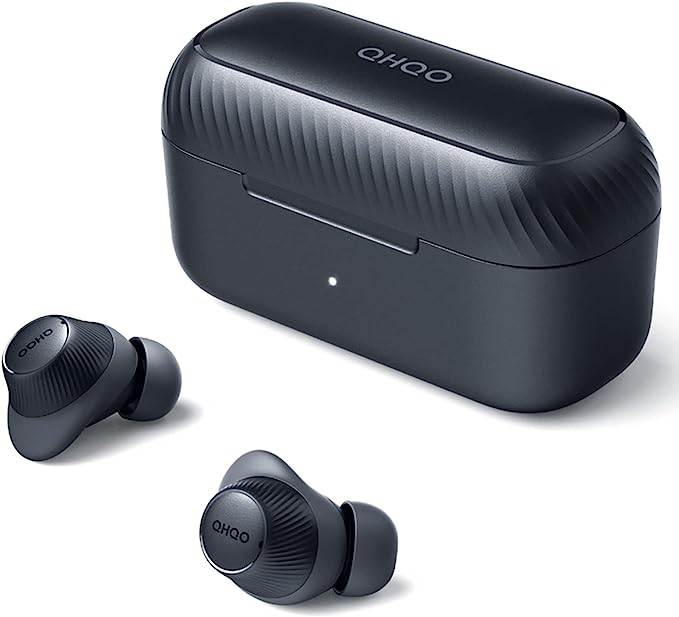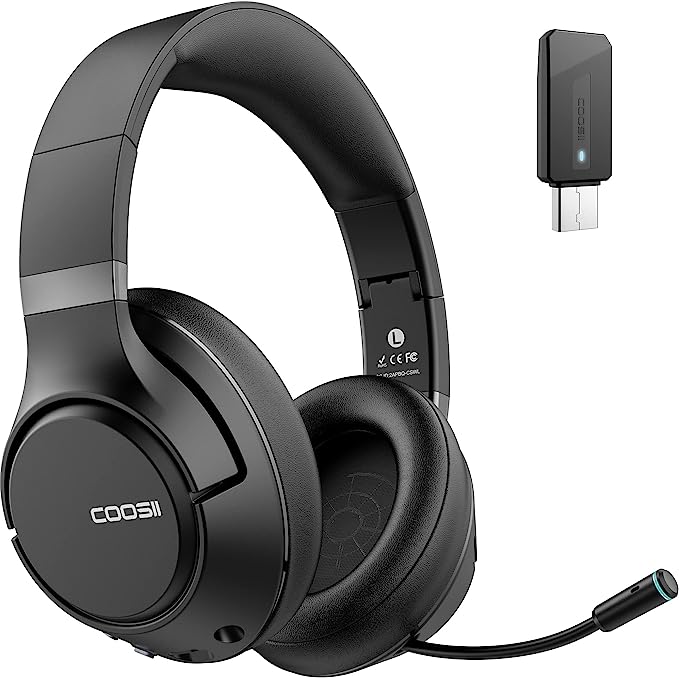We live in an age of quiet revolutions, and one of the most profound has happened right in our ears. The journey from cumbersome, wire-tethered headphones to the almost invisible soundscapes delivered by modern wireless earbuds is a testament to relentless human ingenuity. These tiny marvels, like the QHQO H3 Wireless Earbuds, are not mere gadgets; they are a confluence of sophisticated technologies, each with its own story, its own science. Our journey today isn’t about a simple review of the QHQO H3, with its promised True Wireless Bluetooth Earbuds 5.2 connectivity, notable IPX8 Waterproof rating, and impressive 42H Playtime. Instead, we’ll delve into the how and why – to understand the elegant engineering and scientific principles that bring such everyday magic to life.

The Invisible Handshake – Decoding Bluetooth 5.2 and True Wireless Stereo
Think back, if you will, to the era of portable CD players, their wires snagging on every passerby, or the frustrating untangling ritual before each use. The dream of truly untethered audio was once just that – a dream. Then came Bluetooth, a technology whose name itself, borrowed from the 10th-century Danish King Harald “Bluetooth” Gormsson famed for uniting disparate Danish tribes, hints at its mission: to unite devices, seamlessly and wirelessly.
The QHQO H3 employs Bluetooth 5.2, a significant step in this royal lineage. But what does “5.2” truly signify for your listening experience, beyond just a higher number? It’s about a more robust and intelligent connection. Imagine the airwaves as a bustling city street; Bluetooth 5.2 is like an advanced traffic control system, ensuring data packets (your music, your calls) navigate this congestion with greater speed, fewer collisions (dropouts), and remarkable efficiency. It refines aspects like the LE (Low Energy) Audio capabilities (though full LE Audio feature adoption varies by device), which are foundational for power-efficient, high-quality wireless sound. This efficiency contributes to longer battery life in the earbuds themselves, a critical factor in such compact devices. For the H3, this translates into that “faster and more stable connection” mentioned in its specifications, ensuring your audio stream remains pristine.
And then there’s the subtle sorcery of True Wireless Stereo (TWS). Before TWS, “wireless” headphones often had a wire connecting the two earpieces. TWS earbuds, like the H3, perform a continuous, delicate ballet. Each earbud independently communicates with your phone (or other source device) and, crucially, with each other, ensuring both left and right channels are perfectly synchronized. Early TWS systems often used one earbud as a “master” relaying to the “slave.” More modern approaches, often facilitated by advancements within Bluetooth versions like 5.2, allow for more independent and robust connections for each earbud, reducing latency – that annoying delay between video and audio – and improving overall stability. It’s this intricate, split-second coordination that delivers that immersive stereo experience without a single physical tether. The QHQO H3’s claim of easy, automatic pairing after the initial setup is a direct beneficiary of these Bluetooth advancements. Furthermore, the mention of AAC (Advanced Audio Coding) support, noted by users, is significant. AAC is an audio codec that provides excellent sound quality, especially favored by Apple devices, ensuring that the wireless handshake doesn’t unduly compromise the audio fidelity.
For you, the listener, this intricate dance of radio waves and protocols translates into pure, unadulterated freedom. It’s the liberty to leave your phone on the bench while you work out, to take a call while your hands are full, or simply to lose yourself in music without the tyranny of the tangled cord. This is the invisible handshake, a constant, reliable connection that just works.

The Enduring Beat – Unpacking 42 Hours of Power in Your Pocket
The liberation provided by wireless technology brings with it a fundamental challenge: power. How do you sustain these marvels of miniaturization for not just a few hours, but for days? The QHQO H3 boasts an impressive total playtime of around 42 hours – over 7 hours from the earbuds themselves, and an additional 35 hours मुहैया कराई गई (provided by) the charging case. This auditory marathon is largely powered by the unsung hero of modern portable electronics: the Lithium-Polymer (Li-Po) battery.
Think of a Li-Po battery as a tiny, incredibly dense energy bar for your electronics. These batteries, a refinement of lithium-ion technology, use a polymer electrolyte instead of a liquid one, allowing for more flexible shapes and thinner profiles – essential for the compact design of an earbud. Their magic lies in the controlled movement of lithium ions between an anode and a cathode during charge and discharge cycles. The H3’s ability to eke out over 7 hours from the diminutive earbuds is a balancing act of battery capacity, the power efficiency of its Bluetooth 5.2 chip, and the energy demands of its audio drivers. One user review for the H3 mentioned a 45mAh capacity per earbud, a respectable figure that, combined with efficient components, makes such playtime achievable.
The charging case, then, isn’t just a convenient holder; it’s a lifeline, a personal power reservoir. It effectively carries several full recharges for the earbuds (accounting for the extra 35 hours of playtime). When the case itself needs replenishment, the H3 offers the modern convenience of both USB-C – the increasingly universal standard for wired charging – and wireless charging. This latter feature, often employing the Qi standard, is a small wonder of physics. Based on Faraday’s law of induction, a transmitter coil in the charging pad creates an oscillating magnetic field, which in turn induces a current in a receiver coil within the H3’s case, replenishing its battery without any physical connection. It’s an invisible energy hand-off, adding a layer of effortless convenience.
The user reward for this sophisticated power management? Days of uninterrupted music, podcasts, and calls. It’s the peace of mind of knowing that even if you forget a nightly charge, your audio companion is likely ready for another day’s journey, minimizing that modern malady known as “battery anxiety.” While one user noted the charging display could be more informative, the sheer endurance offered is a significant practical benefit.

Braving the Elements – The Protective Embrace of IPX8 Waterproofing
Life is wonderfully unpredictable, and sometimes it makes a splash – literally. Whether it’s an intense workout, a sudden downpour during your commute, or an accidental fumble near the sink, moisture has traditionally been the nemesis of delicate electronics. This is where the QHQO H3 earbuds step up with their IPX8 waterproof rating, offering a significant shield against the aquatic unknown.
But what does “IPX8” truly mean beyond a reassuring label? The “IP” stands for Ingress Protection, an international standard (IEC 60529) that classifies the degrees of protection provided by enclosures of electrical equipment. The code consists of two digits:
* The first digit (represented by ‘X’ in IPX8) rates protection against solid particles like dust. An ‘X’ here doesn’t mean no protection; it typically means the device hasn’t been specifically tested or rated for dust ingress by the manufacturer under this standard, or they choose not to specify it for this particular rating.
* The second digit, ‘8’ in this case, is where the aquatic resilience shines. An IPX8 rating signifies that the equipment is suitable for continuous immersion in water under conditions specified by the manufacturer, which are generally more severe than the IPX7 rating (which covers immersion up to 1 meter for 30 minutes). While QHQO’s product information doesn’t detail the exact depth and duration for its IPX8 claim (manufacturers define this beyond the 1-meter baseline), it unequivocally indicates a high level of water protection, capable of handling submersion, not just splashes.
How is this watery defense engineered into something as small as an earbud? It’s a combination of meticulous design and material science. This often involves precision-engineered seals around any openings, the use of water-resistant adhesives, and sometimes hydrophobic nano-coatings applied to internal components, causing water to bead up and roll off rather than seep in. The goal is to create a miniature fortress against moisture.
For the user, this translates to a remarkable degree of freedom and durability. You can confidently wear the H3 earbuds during a sweat-drenched gym session, on a run in the rain, or without panic if they take an unexpected brief dip. It’s a practical peace of mind. However, it’s crucial to remember a detail the product information wisely points out: this IPX8 rating applies to the earbuds themselves, not the charging case. The case, with its charging ports and more complex openings, prefers to stay on dry land.
The Anatomy of Audio Pleasure – Sound, Sensation, and Seamless Interaction
Ultimately, an earbud’s primary mission is to deliver sound, and to do so in a way that is both pleasurable and comfortable. The QHQO H3 promises “excellent sound quality” with “immersive sound,” “thick bass,” and “clear and soft” mid and high tones. While the perception of audio quality is wonderfully subjective, shaped by personal preferences and even our unique ear anatomy, we can explore the technical and design considerations that aim for such an experience.
The in-ear design of the H3, coupled with the provision of three different sizes of skin-friendly eartips, is foundational. A proper seal between the eartip and the ear canal is paramount. This seal does several crucial things: it provides passive noise isolation, blocking out some ambient sound and allowing you to focus on the audio; it ensures that the bass frequencies, which require a sealed chamber to be perceived fully, are delivered effectively (often referred to as achieving a good “bass lock”); and it helps keep the earbuds securely in place.
One customer review mentioned a “typical V-shaped frequency response,” which is a common tuning choice in consumer audio. This “V-shape” refers to an audio signature where bass and treble frequencies are emphasized relative to the midrange. There’s a psychoacoustic reason for its popularity: our hearing is less sensitive to bass and treble at lower volumes (as described by the Fletcher-Munson curves or equal-loudness contours). A V-shaped tuning can make music sound more lively, powerful, and “fun” at typical listening levels, especially for genres like pop, rock, and electronic music. However, audiophiles seeking a more neutral or “flat” response for critical listening might perceive it differently. The H3 aims to provide a sound that is “thick and not stuffy” in the bass and “clear and soft” in the higher registers, suggesting an effort to balance this V-shape for broad appeal.
Beyond the sound itself, the interaction with the H3 is managed via Smart Touch controls. This technology likely uses capacitive sensors, similar to those in your smartphone screen, embedded in the surface of the earbuds. These sensors detect the slight electrical charge değişiklikleri (changes) when your finger makes contact, translating taps into commands: play/pause, skipping tracks, answering calls, or, with four taps, activating your phone’s voice assistant (like Siri or Google Assistant). This offers a convenient way to manage your audio and calls without constantly reaching for your phone.
For call clarity, the inclusion of multiple microphones on each earbud is a key feature. This setup enables techniques like beamforming, where the microphones work in concert to focus on the speaker’s voice, and noise reduction algorithms that help to filter out ambient sounds. The result is that your voice is transmitted more clearly to the person on the other end of the call, even in less-than-ideal environments.
Combined, these elements – a secure and comfortable fit crucial for acoustics, a potentially engaging sound signature, and intuitive controls – contribute to the overall sensory experience. It’s about creating a seamless and enjoyable auditory bubble, whether you’re lost in a symphony, engrossed in a podcast, or deep in conversation.

The Ongoing Overture of Innovation
The QHQO H3 Wireless Earbuds, with their blend of Bluetooth 5.2, extended battery life, robust IPX8 waterproofing, and considered audio design, serve as a compelling example of how complex science and meticulous engineering are distilled into accessible, everyday technology. They represent a note in the continuous, evolving symphony of personal audio – a field driven by the desire for greater freedom, deeper immersion, and more effortless connection.
Beyond the specifications and features of any single device, it’s worth appreciating the broader human ingenuity at play. Each time you pop in your wireless earbuds and the world fades into your chosen soundtrack, you’re experiencing the culmination of decades of research in radio technology, materials science, acoustics, and power management. It’s a testament to our relentless pursuit of making technology not just functional, but an almost invisible extension of our lives.
The world is full of unheard symphonies, both literal and metaphorical. As technology like this continues to break down barriers and enhance our senses, my best advice is simple: Keep listening. Keep exploring. And keep marveling at the quiet magic that surrounds us.




